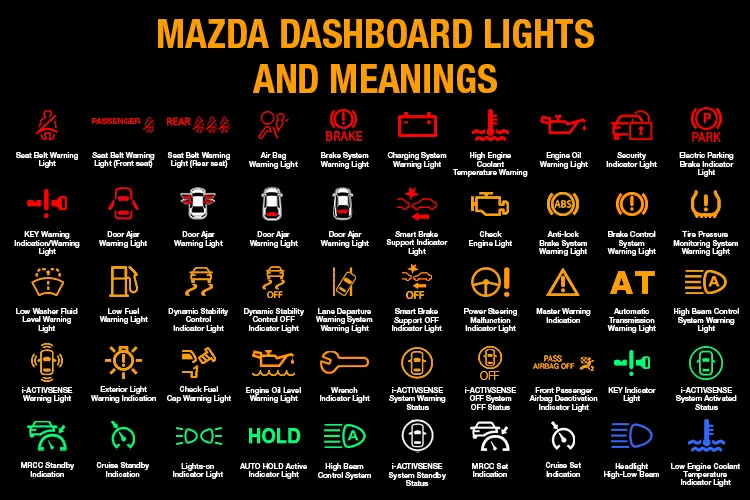Decoding the Mazda CX-5 Dashboard Warning Lights: A Driver’s Guide
Your Mazda CX-5 is a sophisticated machine, packed with technology to enhance your driving experience. But sometimes, the most crucial information isn’t found on the infotainment screen – it’s right in front of you, in the form of your dashboard warning lights. These illuminated symbols, often overlooked, are your vehicle’s way of communicating potential issues, ranging from minor inconveniences to serious safety hazards. Understanding what these lights mean is paramount to maintaining your CX-5’s performance and ensuring your safety on the road. This comprehensive guide will decode the most common Mazda CX-5 dashboard warning lights, empowering you to take appropriate action.
Understanding the Basics: Warning Light Colors and Their Significance
Before diving into specific symbols, it’s essential to understand the general meaning behind the colors used for warning lights:
- Red: Indicates a serious issue that requires immediate attention. Continuing to drive with a red warning light illuminated can lead to significant damage or endanger your safety. Pull over safely and consult your owner’s manual or seek professional assistance as soon as possible.
- Yellow/Amber: Signals a less urgent problem that still needs attention. You should address the issue as soon as possible, but it generally doesn’t require an immediate stop. Schedule an inspection with a qualified mechanic.
- Green/Blue: These lights are informational and indicate that a system is active or functioning correctly. For example, your headlights or cruise control are engaged.
Common Mazda CX-5 Warning Lights and Their Meanings
Here’s a breakdown of some of the most frequently encountered warning lights on your Mazda CX-5 dashboard:
Engine-Related Warning Lights
- Check Engine Light: (Yellow/Amber) This is perhaps the most recognizable and concerning light. It indicates a malfunction within the engine or emissions system. The cause can range from a loose gas cap to a more serious problem. Get your vehicle scanned by a professional as soon as possible.
- Oil Pressure Warning Light: (Red) Shaped like an oil can, this light signifies low oil pressure. Stop driving immediately. Low oil pressure can cause severe engine damage. Check your oil level and add oil if necessary. If the light persists, contact a mechanic.
- Engine Coolant Temperature Warning Light: (Red) A thermometer symbol that indicates the engine is overheating. Stop driving immediately. Overheating can warp engine components. Pull over safely, turn off the engine, and allow it to cool down. Check your coolant level when it is safe to do so. If the light persists after topping off the coolant, seek professional assistance.
- Malfunction Indicator Lamp (MIL): (Yellow/Amber) Similar to the Check Engine Light, this indicates a problem within the engine system. It may be accompanied by a specific code that can be read with a diagnostic tool.
Brake System Warning Lights
- Brake System Warning Light: (Red) This light can illuminate for several reasons:
- Low brake fluid level.
- The parking brake is engaged.
- A problem with the braking system itself. Never drive with this light illuminated. Check your parking brake, and if it’s not engaged, check your brake fluid level. If the light persists, have your brakes inspected immediately.
- Anti-lock Braking System (ABS) Warning Light: (Yellow/Amber) A circle with “ABS” inside. This light indicates a malfunction in the ABS system. Your brakes will still function, but without the assistance of ABS. Schedule an inspection with a mechanic.
Safety and Driver Assistance Warning Lights
- Airbag Warning Light: (Red) A person wearing a seatbelt with a circular object in front of them. This light indicates a problem with the airbag system. Airbags may not deploy in an accident if this light is on. Have the system inspected immediately.
- Tire Pressure Monitoring System (TPMS) Warning Light: (Yellow/Amber) A horseshoe-shaped symbol with an exclamation point. This light indicates low tire pressure in one or more tires. Check your tire pressures and inflate them to the recommended levels indicated on the driver’s side doorjamb.
- Lane Departure Warning System (LDW) / Lane Keep Assist System (LKA) Warning Light: (Yellow/Amber) This light indicates a malfunction in the LDW or LKA system. Have the system inspected by a mechanic.
- Blind Spot Monitoring (BSM) Warning Light: (Yellow/Amber) This light indicates a malfunction in the BSM system. Have the system inspected by a mechanic.
Other Important Warning Lights
- Battery Charging System Warning Light: (Red) A battery symbol. This light indicates a problem with the charging system, such as a faulty alternator or a loose connection. Have the system inspected as soon as possible.
- Power Steering Malfunction Indicator Light: (Yellow/Amber) A steering wheel symbol with an exclamation point. This light indicates a problem with the power steering system. This can make steering difficult. Have the system inspected by a mechanic.
- Key Warning Light: (Yellow/Amber) A key-shaped symbol, often with a car outline. This light indicates a problem with the key fob or the immobilizer system. Check your key fob battery or consult your owner’s manual.
- Seat Belt Reminder Light: (Red) A person wearing a seatbelt. This light reminds you to buckle up.
What to Do When a Warning Light Illuminates
- Identify the Light: Familiarize yourself with the dashboard symbols in your owner’s manual.
- Assess the Color: Red lights require immediate attention. Yellow/amber lights require prompt attention.
- Consult Your Owner’s Manual: Your manual provides detailed explanations of each warning light and recommended actions.
- Take Action: Follow the recommended actions outlined in your owner’s manual.
- Seek Professional Help: If the light persists or you are unsure of the problem, contact a qualified mechanic for diagnosis and repair.
Conclusion: Prioritizing Your Safety and Your CX-5’s Health
Understanding your Mazda CX-5’s dashboard warning lights is a crucial aspect of responsible vehicle ownership. By recognizing and responding appropriately to these signals, you can address potential issues early, preventing more significant damage and ensuring your safety on the road. Regularly consult your owner’s manual, schedule routine maintenance, and don’t hesitate to seek professional assistance when needed. Your CX-5 will thank you for it, and so will your peace of mind.
Frequently Asked Questions (FAQs)
- What should I do if multiple warning lights illuminate simultaneously? This usually suggests a more complex problem. Prioritize red lights and address those immediately. Then, consult your owner’s manual and schedule an inspection with a mechanic to diagnose the root cause of the multiple issues.
- Can I drive with the Check Engine Light illuminated? Yes, but it’s best to get it diagnosed as soon as possible. The cause could be minor (like a loose gas cap), but it could also indicate a more serious problem that could worsen over time.
- My dashboard light came on, but now it’s off. Do I still need to get it checked? Yes. The issue that triggered the light could still exist and may reappear. Also, the underlying problem may have caused damage that requires repair.
- Where can I find the recommended tire pressure for my Mazda CX-5? The recommended tire pressure is located on a sticker on the driver’s side doorjamb. It’s also typically listed in your owner’s manual.
- How often should I have my Mazda CX-5 serviced? Follow the maintenance schedule outlined in your owner’s manual. This schedule usually includes oil changes, filter replacements, and other routine services based on mileage and time.




